How to Improve the Total Cost of Ownership of Electric Vehicles: An Analysis of the Light Commercial Vehicle Segment
Abstract
1. Introduction
2. Materials and Methods
2.1. The Total Cost of Ownership (TCO)
- Analysis of every stream of periodic costs;
- Calculation of the present value of the one-time and the recurring costs;
- Division of the present value by the number of kilometers during the vehicle lifetime in order to compute a cost per kilometer.
2.2. Assumptions of the Model
2.2.1. Period of Ownership
2.2.2. Discount Rate
2.2.3. Cost of Ownership
2.3. Scope of the Market Research
3. Results
4. Discussion
4.1. Kilometers Driven
4.2. Years of Ownership
4.3. Residual Value of the Battery
4.4. Fiscal System
4.5. Kilometer-Based Charge
5. Conclusions
Author Contributions
Funding
Conflicts of Interest
References
- IPCC. Synthesis Report: Global Warming of 1.5 °C—Summary for policy makers. 2018. Available online: https://www.ipcc.ch/site/assets/uploads/sites/2/2018/07/SR15_SPM_version_stand_alone_LR.pdf (accessed on 26 March 2019).
- EC. EU Transport in Figures—Statistical Pocketbook 2019; EC: Brussels, Belgium, 2019. [Google Scholar]
- EEA. Appropriate Taxes and Incentives Do Affect Purchases of New Cars; EEA: Oshkosh, WI, USA, 2018. [Google Scholar]
- Lebeau, P. Towards the Electrification of City Logistics? Ph.D. Thesis, Vrije Universiteit Brussel, Brussels, Belgium, 2016. [Google Scholar]
- Statbel. The Vehicle Fleet in Belgium in 2018. Available online: https://statbel.fgov.be/en/themes/mobility/traffic/vehicle-stock (accessed on 26 March 2019).
- Van Mierlo, J.; Messagie, M.; Rangaraju, S. Comparative environmental assessment of alternative fueled vehicles using a life cycle assessment. World Conf. Transp. Res. 2017, 25, 3435–3445. [Google Scholar] [CrossRef]
- EC. White Paper: Roadmap to A Single European Transport Area; EC: Brussels, Belgium, 2011. [Google Scholar]
- Lebeau, P.; Macharis, C.; Van Mierlo, J. Exploring the choice of battery electric vehicles in city logistics: A conjoint-based choice analysis. Transp. Res. Part E 2015, 91, 245–258. [Google Scholar] [CrossRef]
- Palmer, K.; Tate, J.; Wadud, Z.; Nellthorp, J. Total cost of ownership and market share for hybrid and electric vehicles in the UK, US and Japan. Appl. Energy 2018, 209, 108–119. [Google Scholar] [CrossRef]
- De Clerck, Q.; Van Lier, T.; Messagie, M.; Macharis, C.; Van Mierlo, J.; Vanhaverbeke, L. Total Cost for Society: A persona-based analysis of electric and conventional vehicles. Transp. Res. Part D Transp. Environ. 2018, 64, 90–110. [Google Scholar] [CrossRef]
- Levay, P.Z.; Drossinos, Y.; Thiel, C. The effect of fiscal incentives on market penetration of electric vehicles: A pairwise comparison of total cost of ownership. Energy Policy 2017, 105, 524–533. [Google Scholar] [CrossRef]
- Lee, D.-Y.; Thomas, V.M.; Brown, M.A. Electric urban delivery trucks: Energy use, greenhouse gas emissions, and cost-effectiveness. Environ. Sci. Technol. 2013, 47, 8022–8030. [Google Scholar] [CrossRef] [PubMed]
- CALSTART. Best Fleet Uses, Key Challenges and the Early Business Case for E-Trucks: Findings and Recommendations of The E-Truck Task Force. 2012. Available online: https://calstart.org/wp-content/uploads/2018/10/Best-Fleet-Uses-Key-Challenges-and-the-Early-Business-Case-for-E_Trucks.pdf (accessed on 27 November 2019).
- Davis, B.A.; Figliozzi, M.A. A methodology to evaluate the competitiveness of electric delivery trucks. Transp. Res. Part E Logist. Transp. Rev. 2013, 49, 8–23. [Google Scholar] [CrossRef]
- Feng, W.; Figliozzi, M. An economic and technological analysis of the key factors affecting the competitiveness of electric commercial vehicles: A case study from the USA market. Transp. Res. Part C Emerg. Technol. 2013, 26, 135–145. [Google Scholar] [CrossRef]
- Taefi, T.T.; Stütz, S.; Fink, A. Assessing the cost-optimal mileage of medium-duty electric vehicles with a numeric simulation approach. Transp. Res. Part D Transp. Environ. 2017, 56, 271–285. [Google Scholar] [CrossRef]
- Browne, M.; Allen, J.; Nemoto, T.; Visser, J. Light goods vehicles in urban areas. Procedia Soc. Behav. Sci. 2010, 2, 5911–5919. [Google Scholar] [CrossRef]
- Camilleri, P.; Dablanc, L. An assessment of present and future competitiveness of electric commercial vans. J. Earth Sci. Geotech. Eng. 2017, 7, 337–364. [Google Scholar]
- ADEME. Cross-Sector Review of the Impact of Electrification by Segment. 2018. Available online: https://www.ademe.fr/sites/default/files/assets/documents/projet-e4t-bilan-impact-electrification-2018_version_anglaise.pdf (accessed on 27 December 2019).
- Lebeau, P.; Macharis, C.; Van Mierlo, J.; Lebeau, K. Electrifying light commercial vehicles for city logistics? A total cost of ownership analysis. Eur. J. Transp. Infrastruct. Res. 2015, 15, 551–569. [Google Scholar]
- Ellram, L.M. Total cost of ownership: An analysis approach for purchasing. Int. J. Phys. Distrib. Logist. Manag. 1995, 25, 4–23. [Google Scholar] [CrossRef]
- Mearig, T.; Morris, L. Life Cycle Cost Analysis Handbook; Department of Education & Early Development: Juneau, AK, USA, 2018. [Google Scholar]
- ACEA. Vehicles in Use Europe 2017. 2017. Available online: https://www.acea.be/uploads/statistic_documents/ACEA_Report_Vehicles_in_use-Europe_2017.pdf (accessed on 26 March 2019).
- ECB. Long-Term Interest Rate Statistics for EU Member States. 2019. Available online: https://www.ecb.europa.eu/stats/financial_markets_and_interest_rates/long_term_interest_rates/html/index.en.html (accessed on 3 October 2019).
- Plan. Perspectives économiques 2019–2024, Brussels. 2019. Available online: https://www.plan.be/admin/uploaded/201902141222280.Rapport_fev2019_F.pdf (accessed on 26 March 2019).
- FEBIAC. DATADIGEST 2018. 2019. Available online: http://www.febiac.be/public/statistics.aspx?FID=23&lang=FR (accessed on 03 October 2019).
- Fischer, M.; Werber, M.; Schwartz, P.V. Batteries: Higher energy density than gasoline? Energy Policy 2009, 37, 2639–2641. [Google Scholar] [CrossRef]
- ING Economics Department. Future Residual Values of Battery Electric Vehicles Benefit from Increased Rang; ING Economics Department: Amsterdam, The Netherlands, 2019; p. 9. [Google Scholar]
- Bloomberg. Lithium-Ion Battery—Costs and Market. 2017. Available online: http://enerjiye.com/wp-content/uploads/2018/12/battery-market.pdf (accessed on 26 March 2019).
- Berckmans, G.; Messagie, M.; Smekens, J.; Omar, N.; Vanhaverbeke, L.; Van Mierlo, J. Cost Projection of State of the Art Lithium-Ion Batteries for Electric Vehicles Up to 2030. Energies 2017, 10, 1314. [Google Scholar] [CrossRef]
- De Hoog, J.; Timmermans, J.; Ioan-Stroe, D.; Swierczynski, M.; Jaguemont, J.; Goutam, S.; Omar, N.; Van Mierlo, J.; Van Den Bossche, P. Combined cycling and calendar capacity fade modeling of a Nickel-Manganese-Cobalt Oxide Cell with real-life profile validation. Appl. Energy 2017, 200, 47–61. [Google Scholar] [CrossRef]
- Belgium.be. Taux de L’impot des Sociétés. 2019. Available online: https://www.belgium.be/fr/impots/impot_sur_les_revenus/societes/declaration/imposition (accessed on 26 March 2019).
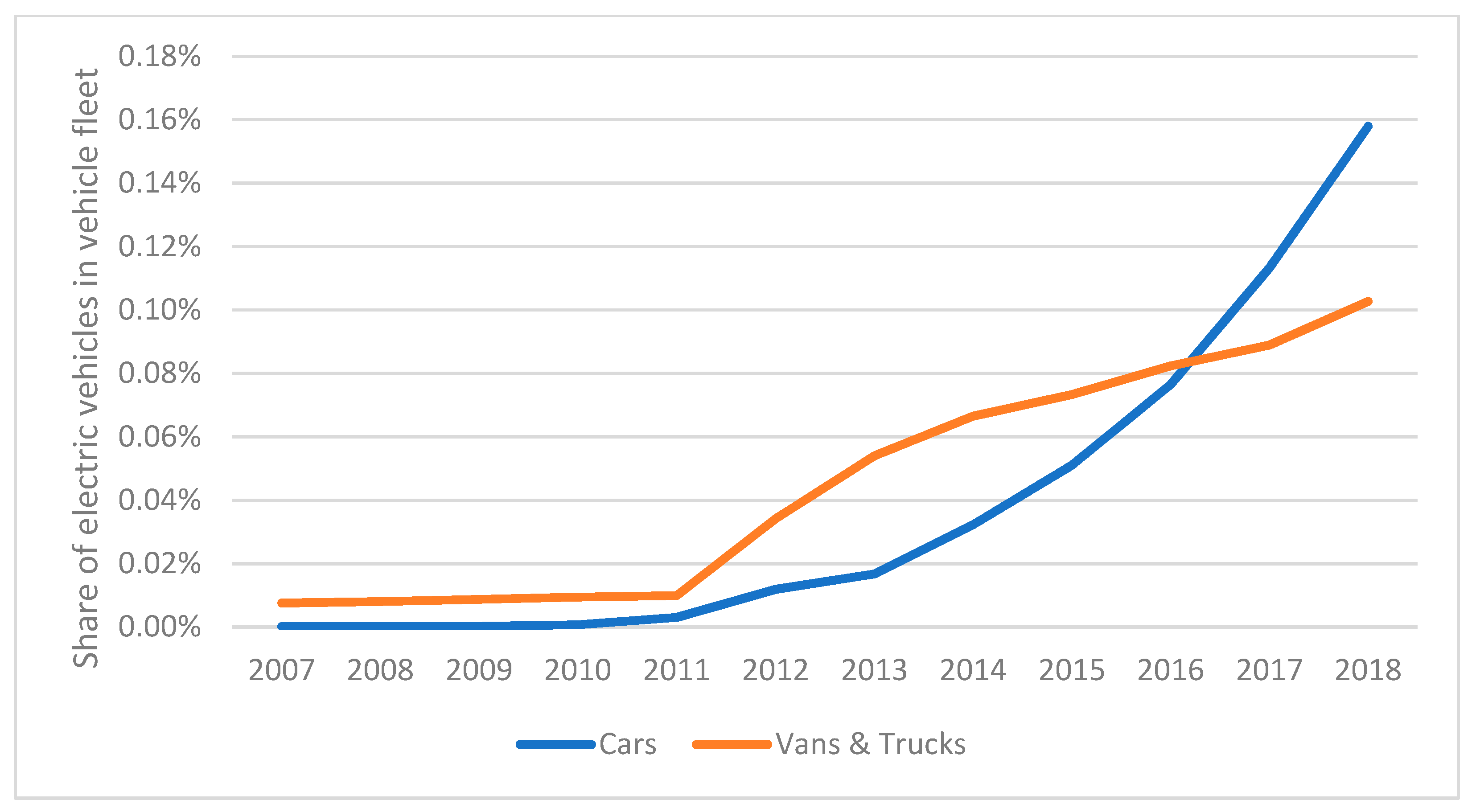
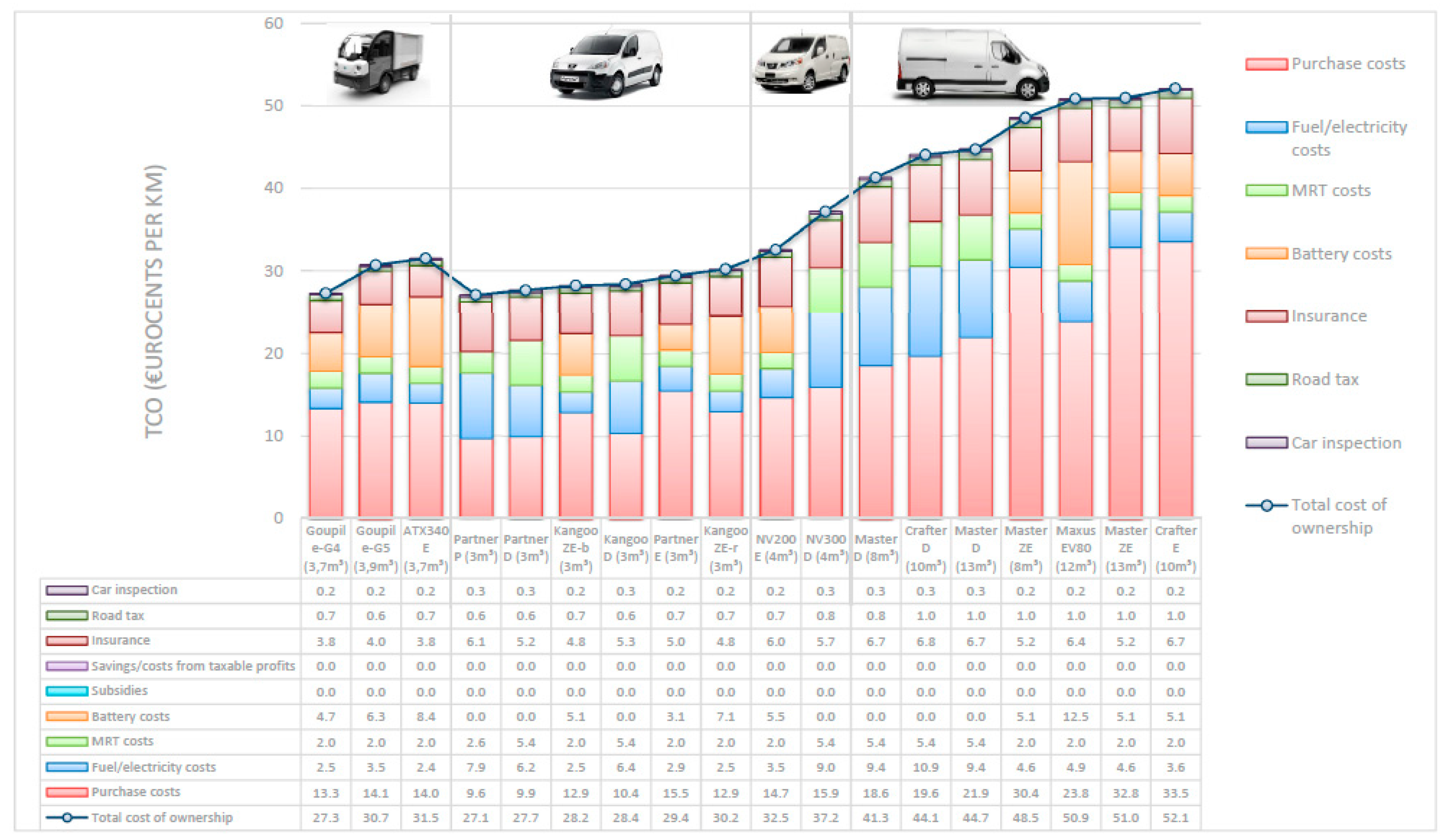
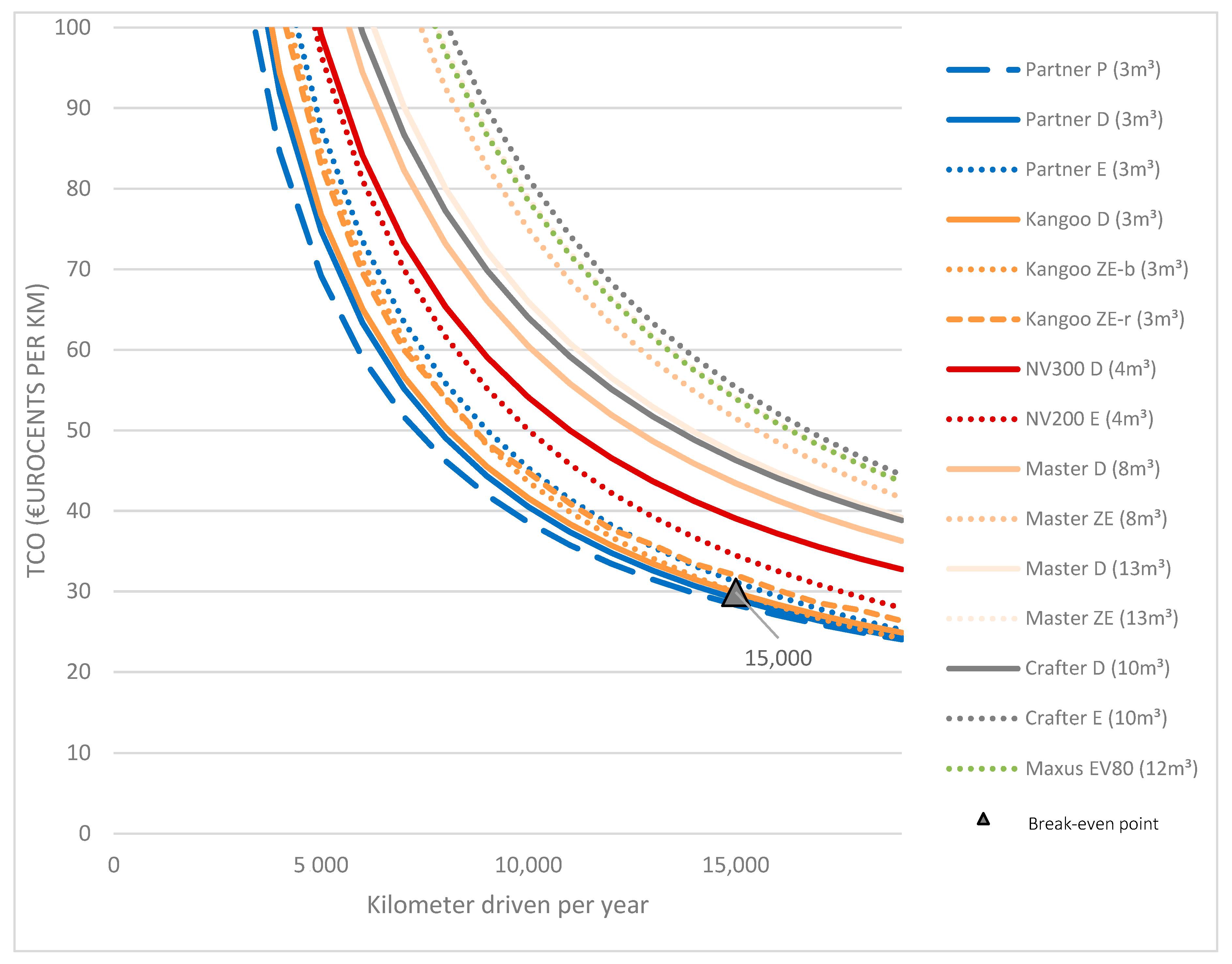


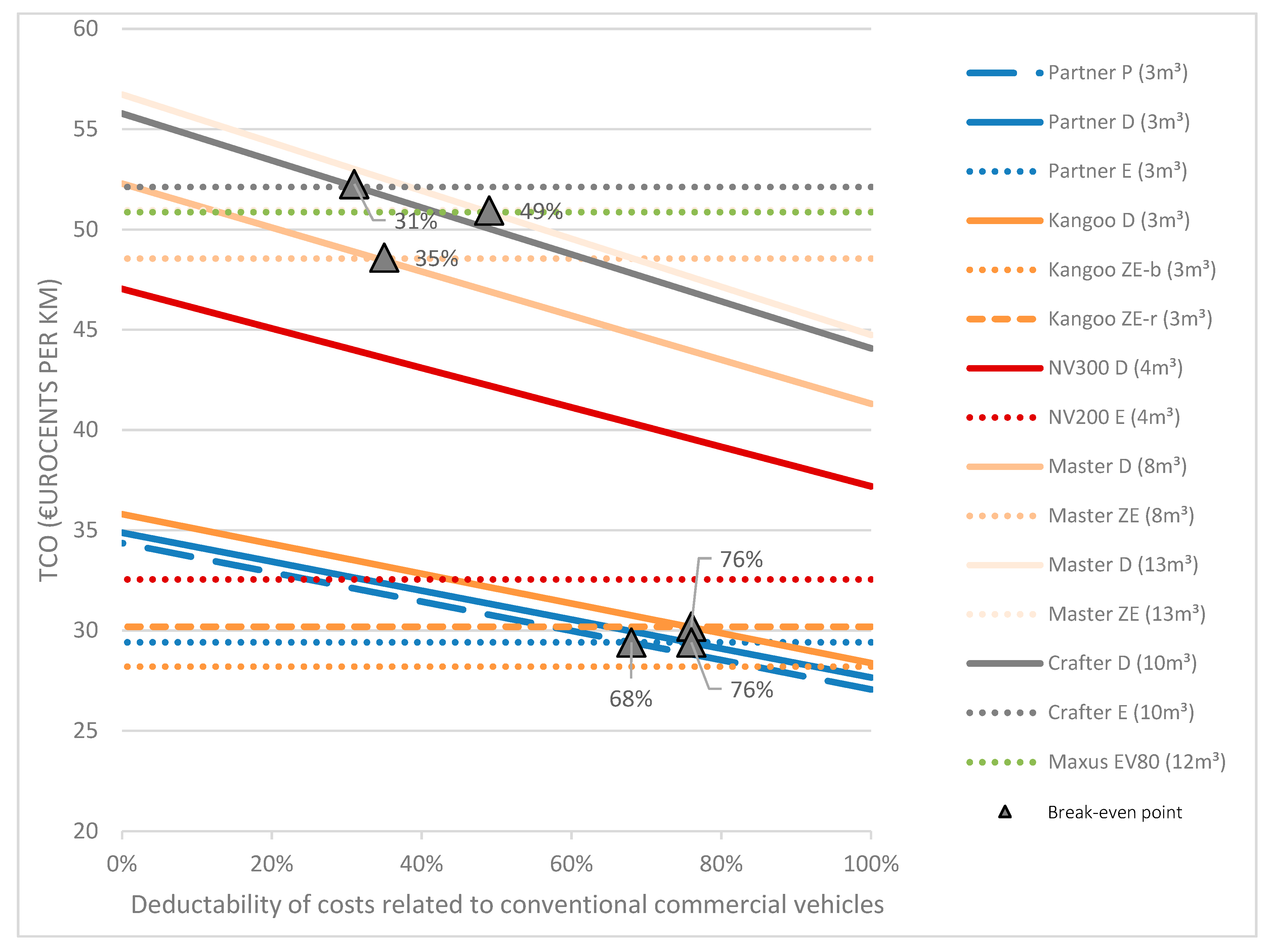
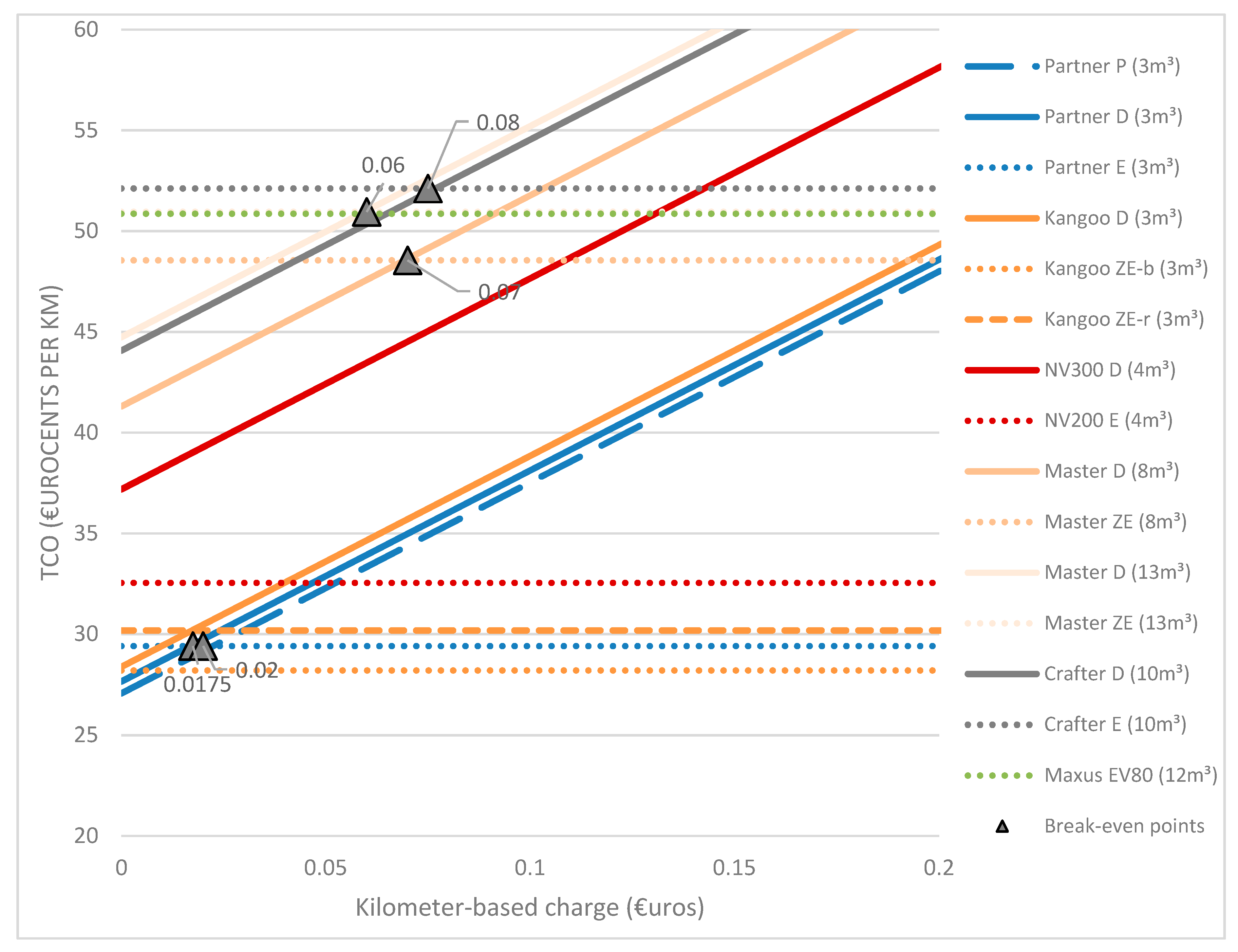
| Name | Volume (m³) | Gross Vehicle Weight (kg) | Purchase Price (€, VAT excl.) | Consumption (l/100 km or kWh/100 km) | Insurance (€, VAT excl.) | Range NEDC (km) | Speed Max (km/h) | Battery Capacity (kWh) | Supposed Battery Price (€, VAT excl.) |
|---|---|---|---|---|---|---|---|---|---|
| Goupil e-G4 (4 m³) | 3.70 | 2100 | 29,260 | 15.0 | 588.23 | 50 | 50 | 7.2 | 6000 |
| Goupil e-G5 (4 m³) | 3.85 | 2000 | 32,650 | 21.0 | 616.57 | 55 | 70 | 11.5 | 8000 |
| Alke ATX 340e (4 m³) | 3.70 | 2150 | 35,200 | 14.3 | 576.17 | 70 | 44 | 10.0 | 10,800 |
| Partner D (3 m³) | 3.30 | 1,980 | 15,060 | 4.70 | 791.31 | - | 152 | - | - |
| Partner P (3 m³) | 3.30 | 1,940 | 15,790 | 6.20 | 927.75 | - | 174 | - | - |
| Partner E (3 m³) | 3.30 | 2,175 | 30,970 | 17.60 | 759.83 | 170 | 110 | 22.5 | 4000 |
| Kangoo D (3 m³) | 3.00 | 1950 | 15,750 | 4.80 | 812.30 | - | 154 | - | - |
| Kangoo ZE-r (3 m³) | 3.00 | 2126 | 22,450 | 15.20 | 733.59 | 200 | 130 | 33.0 | - |
| Kangoo ZE-b (3 m³) | 3.00 | 2126 | 28,950 | 15.20 | 733.59 | 270 | 130 | 33.0 | 6500 |
| D-NV300 (4 m³) | 5.20 | 2780 | 24,080 | 6.80 | 870.03 | - | 158 | - | - |
| E-NV200 (4 m³) | 4.20 | 2240 | 32,620 | 20.60 | 922.50 | 275 | 123 | 40.0 | 7000 |
| Crafter D (11 m³) | 10.70 | 3500 | 29,761 | 8.20 | 1043.19 | - | 160 | - | - |
| Crafter E (11 m³) | 10.70 | 3500 | 65,000 | 21.50 | 1027.45 | 160 | 90 | 35.8 | 6500 |
| Master D (8 m³) | 7.75 | 2800 | 28,150 | 7.10 | 1027.45 | - | 148 | - | - |
| Master D (13 m³) | 12.48 | 3500 | 33,150 | 7.10 | 1027.45 | - | 148 | - | - |
| Master ZE (8 m³) | 8.00 | 3100 | 59,600 | 27.50 | 801.81 | 120 | 100 | 33.0 | 6500 |
| Master ZE (13 m³) | 13.00 | 3100 | 63,800 | 27.50 | 801.81 | 120 | 100 | 33.0 | 6500 |
| Maxus EV80 (11 m³) | 11.50 | 3500 | 57,590 | 29.20 | 985.47 | 192 | 105 | 56.4 | 16,000 |
© 2019 by the authors. Licensee MDPI, Basel, Switzerland. This article is an open access article distributed under the terms and conditions of the Creative Commons Attribution (CC BY) license (http://creativecommons.org/licenses/by/4.0/).
Share and Cite
Lebeau, P.; Macharis, C.; Van Mierlo, J. How to Improve the Total Cost of Ownership of Electric Vehicles: An Analysis of the Light Commercial Vehicle Segment. World Electr. Veh. J. 2019, 10, 90. https://doi.org/10.3390/wevj10040090
Lebeau P, Macharis C, Van Mierlo J. How to Improve the Total Cost of Ownership of Electric Vehicles: An Analysis of the Light Commercial Vehicle Segment. World Electric Vehicle Journal. 2019; 10(4):90. https://doi.org/10.3390/wevj10040090
Chicago/Turabian StyleLebeau, Philippe, Cathy Macharis, and Joeri Van Mierlo. 2019. "How to Improve the Total Cost of Ownership of Electric Vehicles: An Analysis of the Light Commercial Vehicle Segment" World Electric Vehicle Journal 10, no. 4: 90. https://doi.org/10.3390/wevj10040090
APA StyleLebeau, P., Macharis, C., & Van Mierlo, J. (2019). How to Improve the Total Cost of Ownership of Electric Vehicles: An Analysis of the Light Commercial Vehicle Segment. World Electric Vehicle Journal, 10(4), 90. https://doi.org/10.3390/wevj10040090






